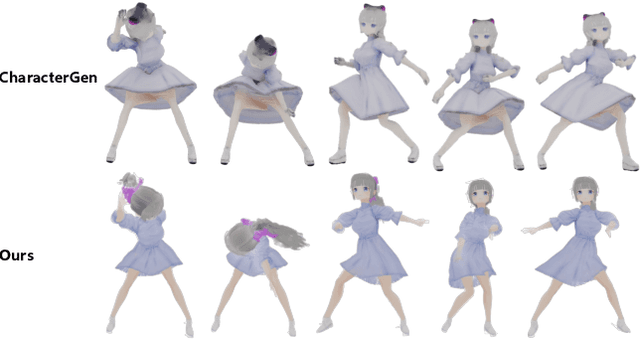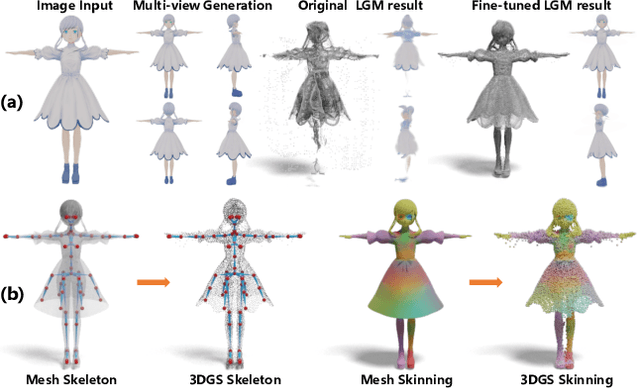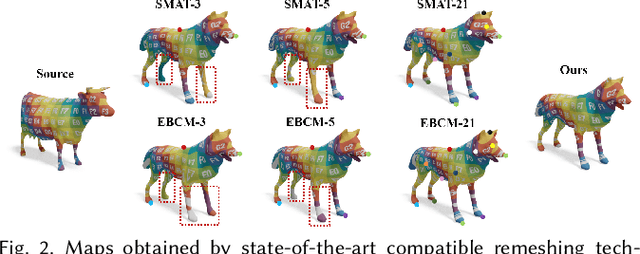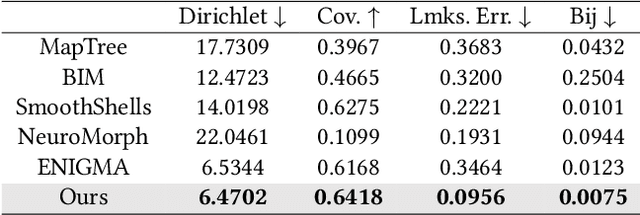Shiwei Mao
Auto-Connect: Connectivity-Preserving RigFormer with Direct Preference Optimization
Jun 13, 2025Abstract:We introduce Auto-Connect, a novel approach for automatic rigging that explicitly preserves skeletal connectivity through a connectivity-preserving tokenization scheme. Unlike previous methods that predict bone positions represented as two joints or first predict points before determining connectivity, our method employs special tokens to define endpoints for each joint's children and for each hierarchical layer, effectively automating connectivity relationships. This approach significantly enhances topological accuracy by integrating connectivity information directly into the prediction framework. To further guarantee high-quality topology, we implement a topology-aware reward function that quantifies topological correctness, which is then utilized in a post-training phase through reward-guided Direct Preference Optimization. Additionally, we incorporate implicit geodesic features for latent top-k bone selection, which substantially improves skinning quality. By leveraging geodesic distance information within the model's latent space, our approach intelligently determines the most influential bones for each vertex, effectively mitigating common skinning artifacts. This combination of connectivity-preserving tokenization, reward-guided fine-tuning, and geodesic-aware bone selection enables our model to consistently generate more anatomically plausible skeletal structures with superior deformation properties.
ARMO: Autoregressive Rigging for Multi-Category Objects
Mar 26, 2025Abstract:Recent advancements in large-scale generative models have significantly improved the quality and diversity of 3D shape generation. However, most existing methods focus primarily on generating static 3D models, overlooking the potentially dynamic nature of certain shapes, such as humanoids, animals, and insects. To address this gap, we focus on rigging, a fundamental task in animation that establishes skeletal structures and skinning for 3D models. In this paper, we introduce OmniRig, the first large-scale rigging dataset, comprising 79,499 meshes with detailed skeleton and skinning information. Unlike traditional benchmarks that rely on predefined standard poses (e.g., A-pose, T-pose), our dataset embraces diverse shape categories, styles, and poses. Leveraging this rich dataset, we propose ARMO, a novel rigging framework that utilizes an autoregressive model to predict both joint positions and connectivity relationships in a unified manner. By treating the skeletal structure as a complete graph and discretizing it into tokens, we encode the joints using an auto-encoder to obtain a latent embedding and an autoregressive model to predict the tokens. A mesh-conditioned latent diffusion model is used to predict the latent embedding for conditional skeleton generation. Our method addresses the limitations of regression-based approaches, which often suffer from error accumulation and suboptimal connectivity estimation. Through extensive experiments on the OmniRig dataset, our approach achieves state-of-the-art performance in skeleton prediction, demonstrating improved generalization across diverse object categories. The code and dataset will be made public for academic use upon acceptance.
DRiVE: Diffusion-based Rigging Empowers Generation of Versatile and Expressive Characters
Nov 26, 2024



Abstract:Recent advances in generative models have enabled high-quality 3D character reconstruction from multi-modal. However, animating these generated characters remains a challenging task, especially for complex elements like garments and hair, due to the lack of large-scale datasets and effective rigging methods. To address this gap, we curate AnimeRig, a large-scale dataset with detailed skeleton and skinning annotations. Building upon this, we propose DRiVE, a novel framework for generating and rigging 3D human characters with intricate structures. Unlike existing methods, DRiVE utilizes a 3D Gaussian representation, facilitating efficient animation and high-quality rendering. We further introduce GSDiff, a 3D Gaussian-based diffusion module that predicts joint positions as spatial distributions, overcoming the limitations of regression-based approaches. Extensive experiments demonstrate that DRiVE achieves precise rigging results, enabling realistic dynamics for clothing and hair, and surpassing previous methods in both quality and versatility. The code and dataset will be made public for academic use upon acceptance.
SRIF: Semantic Shape Registration Empowered by Diffusion-based Image Morphing and Flow Estimation
Sep 18, 2024



Abstract:In this paper, we propose SRIF, a novel Semantic shape Registration framework based on diffusion-based Image morphing and Flow estimation. More concretely, given a pair of extrinsically aligned shapes, we first render them from multi-views, and then utilize an image interpolation framework based on diffusion models to generate sequences of intermediate images between them. The images are later fed into a dynamic 3D Gaussian splatting framework, with which we reconstruct and post-process for intermediate point clouds respecting the image morphing processing. In the end, tailored for the above, we propose a novel registration module to estimate continuous normalizing flow, which deforms source shape consistently towards the target, with intermediate point clouds as weak guidance. Our key insight is to leverage large vision models (LVMs) to associate shapes and therefore obtain much richer semantic information on the relationship between shapes than the ad-hoc feature extraction and alignment. As a consequence, SRIF achieves high-quality dense correspondences on challenging shape pairs, but also delivers smooth, semantically meaningful interpolation in between. Empirical evidence justifies the effectiveness and superiority of our method as well as specific design choices. The code is released at https://github.com/rqhuang88/SRIF.
Spatially and Spectrally Consistent Deep Functional Maps
Sep 05, 2023Abstract:Cycle consistency has long been exploited as a powerful prior for jointly optimizing maps within a collection of shapes. In this paper, we investigate its utility in the approaches of Deep Functional Maps, which are considered state-of-the-art in non-rigid shape matching. We first justify that under certain conditions, the learned maps, when represented in the spectral domain, are already cycle consistent. Furthermore, we identify the discrepancy that spectrally consistent maps are not necessarily spatially, or point-wise, consistent. In light of this, we present a novel design of unsupervised Deep Functional Maps, which effectively enforces the harmony of learned maps under the spectral and the point-wise representation. By taking advantage of cycle consistency, our framework produces state-of-the-art results in mapping shapes even under significant distortions. Beyond that, by independently estimating maps in both spectral and spatial domains, our method naturally alleviates over-fitting in network training, yielding superior generalization performance and accuracy within an array of challenging tests for both near-isometric and non-isometric datasets. Codes are available at https://github.com/rqhuang88/Spatiallyand-Spectrally-Consistent-Deep-Functional-Maps.
 Add to Chrome
Add to Chrome Add to Firefox
Add to Firefox Add to Edge
Add to Edge